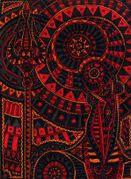Talk:Zohal
Useful links
art
http://crookedtimber.org/2018/12/01/saturday-art-blogging-patterns-in-islamic-art/
https://patterninislamicart.com/
- Eshu art
Exu by Henrique Vieira
makeup and style
style ideas for make up can come from themes in the story and art people have created of Eshu and Orishas. Also, stylistic elements can be taken from aperiodic tilings as well as traditional Islamic mosaics. dazzle art.
Kuchipudi an Indian classical dance. draping for Kuchipudi style
Ornamentations in Indian classical dance
http://www.joojooazad.com/2015/08/tehran-iran-streetstyle-details-details.html
https://www.instagram.com/p/BrLKq6Dnwcr/ Alok in a cool outfit
https://www.instagram.com/p/Bp2X4KRnw1o/ Alok in a cool outfit with really adorable glasses
very amazing hair https://www.instagram.com/p/Bqm-vHdHywb/
Eshu cultural history
Cosentino, Donald. “Who Is That Fellow in the Many-Colored Cap? Transformations of Eshu in Old and New World Mythologies.” The Journal of American Folklore, vol. 100, no. 397, 1987, pp. 261–275. JSTOR, JSTOR, www.jstor.org/stable/540323.
"Eshu's Cap: One day Eshu walked between the farms of two friends wearing a multicolored cap (variously described as red and white; red, white and blue; or red, white, green, and black). He also put his pipe at the nape of his neck and hung his staff over his back. As he passed back and forth, the friends quarreled about his appearance and the direction he was walking, until they came to blows. Later, when the disputants brought him to court, Eshu confessed to the trick, boasting that "sowing dissension is my great delight." Then he fled, starting a fire along the way and mixing up all the possessions of fleeing townsfolk (Pelton 1980:141). Thus testing and exposing friendships, creating and destroying wealth, Eshu exits laughing."
red, black, feather, trickster
Remembrance
young body, old soul. old and young bodies remembered in fragments
emotional intensity of an adolescent flavored with an out-of-context distancing of an elder
travel duration/cost in Roman times http://orbis.stanford.edu/
